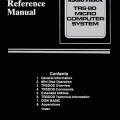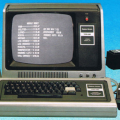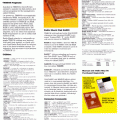MICRODOS
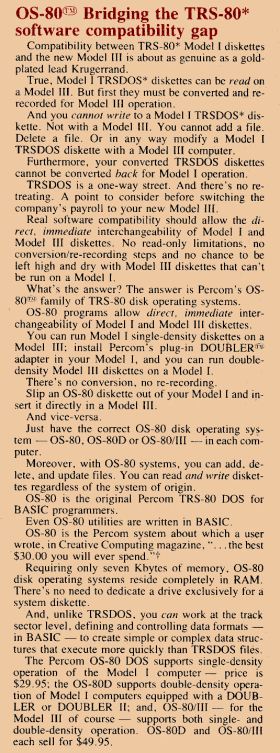
Percom advertisement from 1981
MICRODOS, later known as OS-80, was the only TRS-80 disk operating system that made no attempt at TRSDOS compatibility. It was written by James W. Stutsman and released by Percom in 1979. Rather than using a command shell like Model I TRSDOS, MICRODOS used extensions to BASIC. It implemented most of the Disk BASIC commands added by TRSDOS. Also unlike the other operating systems, MICRODOS had no file system. All disk accesses were made using the starting sector and length. As stated in the manual:
The philosophy at Percom is that a DOS for a microcomputer should make minimal demands on available resources while providing essential functions in accessing the disk. These functions include program save and load and a simple means of storing and retrieving data. Random access of the disk should be as easy to perform as sequential access.
MICRODOS was designed around these principles. Its requirements are small – less than 7K of memory and only 5% of a diskette. Once MICRODOS has been loaded into memory (by power-on or reset) it is no longer dependent on the disk for anything. This, along with the low memory requirement, makes a 16K one-disk system quite useful.
At some point after it was released, MICRODOS was renamed to OS-80. The name OS-80 was used in most Percom advertisements and the name MICRODOS seems to have disappeared by 1980. From a Percom advertisement in the August 1981 issue of 80 Microcomputing:
OS-80, Percom’s fast extendable BASIC-language disk operating system, is included on diskette when you purchase an initial drive kit. Originally called MICRODOS, OS-80 was favorably reviewed in the June 1980 issue of Creative Computing magazine.
By 1981, Percom sold three different versions for the TRS-80:
- OS-80: the original single-density Model I version which sold for $29.95
- OS-80D: the double-density Model I version for the Percom Doubler which sold for $49.95
- OS-80/III: the double-density Model III version which sold for $49.95
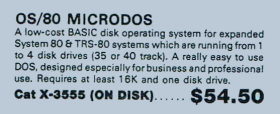
MICRODOS from 1981 Dick Smith catalog (from New Zealand)
MICRODOS had three primary advantages over TRSDOS:
- Size: MICRODOS occupied only 7K of memory. This meant that MICRODOS could work on a 16K system, unlike TRSDOS.
- Speed: MICRODOS was noticeably faster than TRSDOS. This was partly because it didn’t maintain a file system and partly because it was always resident in memory.
- Disk compatibility: Any Model I OS-80 disk could be read using Model III OS-80/III. Not only that, but any programs on it would run unchanged. The same definitely could not be said about Model I TRSDOS 2.3 and Model III TRSDOS 1.3.
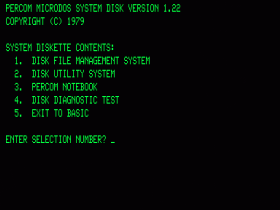
MICRODOS boot screen
- Program compatibility: Most BASIC programs and all machine language programs designed to run under TRSDOS would not work with MICRODOS.
- File compatibility: Because of the lack of a file system, it was difficult to transfer files between MICRODOS and TRSDOS.
Although not as widely remembered as other TRS-80 operating systems, MICRODOS was quite popular within its own niche. Percom continued to advertise and sell MICRODOS well into 1982.
